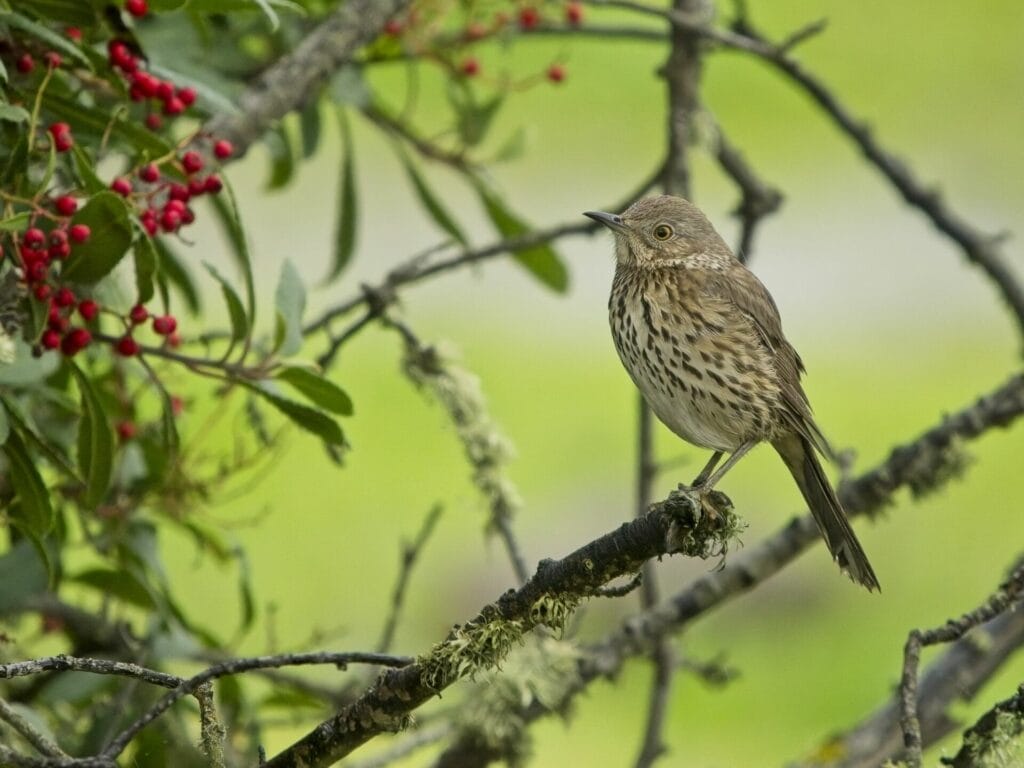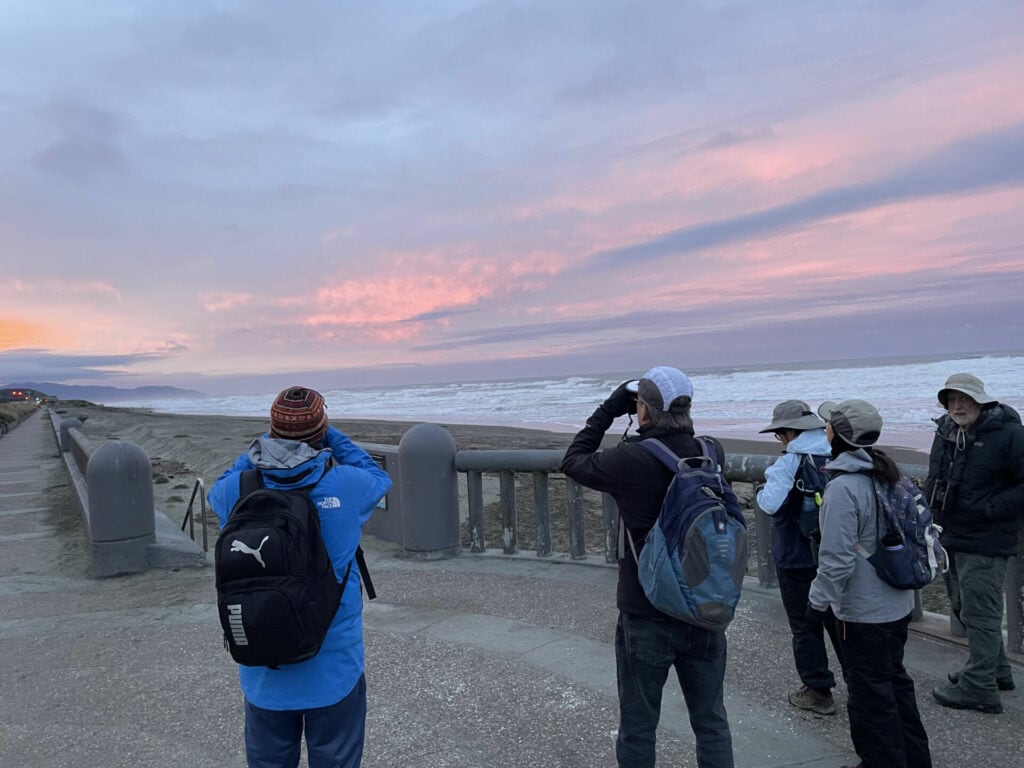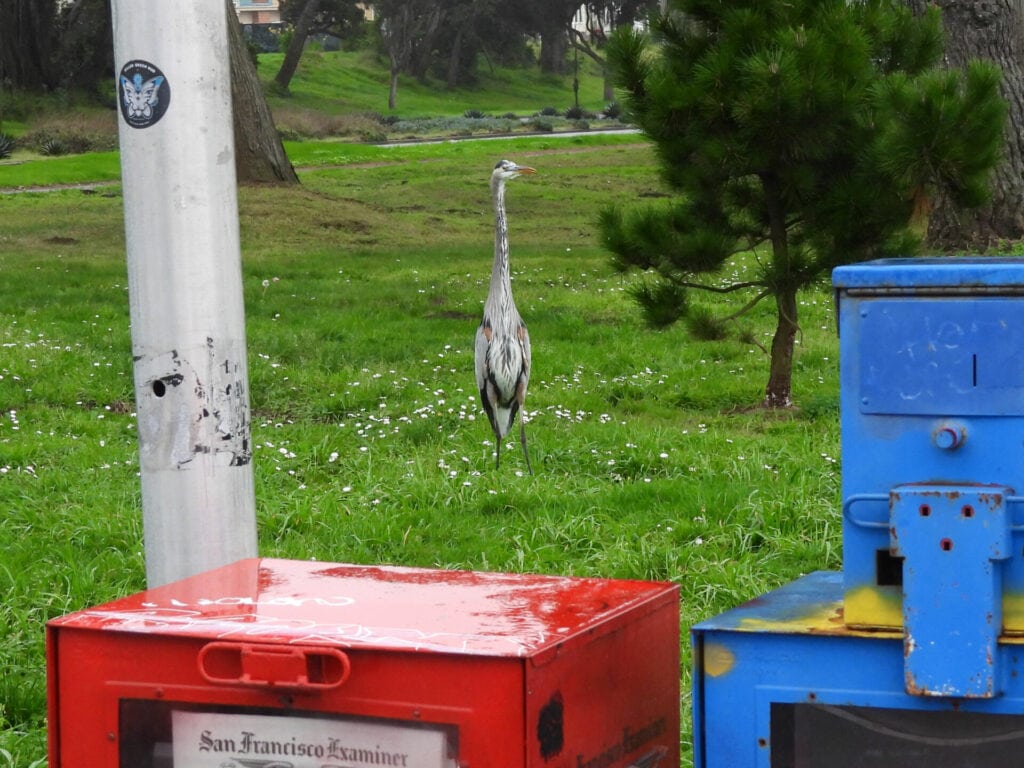SF Christmas Bird Count Report
By David Assmann
Despite rainy weather, a record 190 participants joined the San Francisco Christmas Bird Count, an increase of 68 over last year. It was our highest number ever, and included 25 beginning birders. Fortunately, despite a forecast of rain all day, the rain held off until early afternoon giving dry conditions for most of the morning. However, the boat survey was done the day before the Count, due to the forecast weather conditions.
By the time Count Week (CW) was over, the species tally was at 191, tying the previous record set in 2019. For the official Count Day, our species total was 178, the same as last year. Our total count of birds for the Count Day was 61,671 – up 3,500 from last year but below our numbers from 2020 and 2021. However, if you add the 7,620 birds counted on the boat the day before, our numbers are comparable to 2020 and 2021.

There were 47 rare or uncommon birds found on this year’s count, with 34 of these found on Count Day. For the first time ever, we recorded Elegant Tern on Count Day. It was the only new species added to the Count. We did have a number of species that had only been seen once before, including Winter Wren (first seen in 2022), Gray Catbird (2013), Sage Thrasher (2022), Northern Parula (2005), White-winged Dove (2021) and Magnolia Warbler (2004). One Count Week bird – Black-headed Grosbeak – was also seen for only the second time.
Overall duck numbers were about the same this year as last year, although we missed a number of uncommon species – Harlequin Duck, Barrow’s Goldeneye, Eurasian Wigeon, Common Merganser and Cinnamon Teal. Seen on Count Week were Wood Duck, Redhead, White-winged Scoter and Long-tailed Duck.
Surf Scoter numbers were up somewhat from last year at 703, but still well below historic levels. In 1985 the count for Surf Scoters was 13,600 and as recently as 2015, the count totaled more than 3,000. 194 Northern Shoveler were reported – a fraction of numbers in previous years – there were 7,268 reported in 2000. Greater Scaup numbers are also down significantly – 662 were recorded, well below our high of 8,004 in 1986. Lesser Scaup numbers are down as well – from 2,663 in 1985 to 30 this year. On a more positive note, last year only 1 Northern Pintail was seen – this year we had an unexpected offshore flight of 564, setting a new record.
We missed Cackling Goose and Snow Goose. Seven Greater-white Fronted Geese were reported (we have had 7 for each of the last three counts).

Shorebird numbers varied a lot from last year, and remain well below historic levels. For the first time in five years we missed the Rock Sandpiper at Heron’s Head. Wandering Tattler was missed for the 4th year in a row. We also missed Ruddy Turnstone and Red Knot. On the positive side, we set a new record for Spotted Sandpiper, with 32 tallied, and for Western Sandpiper, with 5,241 counted.
The following species came in at numbers that are more than 90% below their all time highs: Long-billed Curlew at 20 (historic high 195), Long-billed Dowitcher at 20 (200), Short-billed Dowitcher at 13 (850), Least Sandpiper at 245 (2,705), and Killdeer at 107 (1,884). Several other species increased this year over last, but are still below historic levels. Willet numbers jumped from 180 to 461, Dunlin numbers rose to 3,609 from 285 and Wilson’s Snipe numbers came in at 79, only two shy of a record.
Gull numbers dropped from last year, with one exception. Our Herring Gull count of 479 was a new record. Wading bird numbers were down, but not dramatically. Brown Pelican numbers set a new record, soaring to 4,112 from 1,005 last year.
Although the afternoon weather wasn’t great for seawatching, we still had a Red Phalarope, 4 Marbled Murrelets, 5 Ancient Murrelets, a Rhinoceros Auklet, and 2 Red-necked Grebes.
A number of studies have been conducted to determine whether the invasion of Eurasian Collared-Doves is contributing to a decline of our native Mourning Dove since they use the same habitat and eat the same food. More recent studies have determined that while Mourning Doves are declining in number, Eurasian Collared-Dove presence may not be the cause. In San Francisco, the number of Mourning Doves seems to have stabilized – this year we spotted 166, down only 5 from last year’s 171, although still a significant decline from our peak of 1,162 in 1989. The dramatic increase in the number of Eurasian Collared-Doves fell into reverse this year with a tally of 108 – a significant decrease from last year’s record 158.
It’s been a mixed year for woodpeckers. Downy Woodpecker numbers are still down, increasing marginally from last year’s 23 to 26. This is the second lowest total in 17 years. There were fewer Nuttall’s Woodpeckers as well, with the numbers dropping from last year’s 96 to 77 this year. A dozen years ago, Nuttall’s were fairly scarce with numbers in the single digits. We set another new record for Hairy Woodpeckers, with 30 this year.
Thrush numbers dropped this year, with about half as many American Robins as last year (1,040 vs 2,141) and Hermit Thrushes dropped from 489 to 137.
Sparrow numbers were down significantly this year, with Dark-eyed Juncos dropping from 898 to 690 and White-crowned Sparrows numbers continuing a four year slide, from 4,583 in 2020 to 2,145 this year. Golden-crowned Sparrow numbers were also down significantly from 2,004 last year to 923.
A Lucy’s Warbler in Golden Gate Park was the 3rd sighting for the count. Altogether we had 12 warbler species (up from 8 last year). There were 3 Wilson’s Warblers, 2 Black-throated Gray Warblers, a Black-and-white Warbler, a Nashville Warbler and a Yellow Warbler. A Palm Warbler was missed on the count, but seen during Count Week. If it seems like there are fewer Yellow-rumped Warblers this year, the count confirms it, with the numbers dropping to 1,276 from 1,753 last year and 2,685 in 2021. Townsend’s Warbler numbers dropped from 384 last year to 308.
Two Orchard Orioles were seen on the count, and a Baltimore Oriole was seen during Count Week. We had a record 5 Summer Tanagers on the count – the previous high was 2 in 1983.
Finch numbers have nose-dived since 2020, with all species showing a significant decline – House Finch from 1,261 to 565, Purple Finch from 137 to 18, Pine Siskin from 792 to 79, and Lesser Goldfinch from 336 to 73. Brown Creeper numbers, on the other hand, are up significantly to a record breaking 80 this year. Red-breasted Nuthatches are traditionally an irruptive species – last year we had none but this year we had 51. This follows a pattern of small numbers some years and large numbers on other years.
Raptor numbers were mostly stable, with a few exceptions. We had our lowest number of American Kestrels ever at 7. On the other hand, we had a high count of 3 Bald Eagles and our third Golden Eagle.
While jay numbers have declined, the number of crows and ravens have skyrocketed. It may be hard to believe, but in the mid-1980s, American Crow numbers were in the single digits. This year we tallied 2,627, up from 1,059 last year. In 1984, we counted 14 Common Ravens – this year we had 1,119.
Other good sightings this year included a Tropical Kingbird, a Rock Wren (cw), Scaly-breasted Munia (cw), and a Western Tanager. We had a record 25 Barn Swallows this year.Peter Pyle speculated that these may be birds that would have migrated south from northern South America to Argentina for the southern summer, but migrated north instead. An article in ScienceDirect details the flexibility and speed by which these swallows can change their migration behavior, including extending their breeding range into Argentina 40 years ago, switching their entire annual cycle by about 6 months.

Next year the count will be on Friday December 27th – mark your calendars.
Heartfelt thanks to all the counters who participated this year, including those who made this their first Christmas Bird Count. Many thanks as well to Keith Maley who joined as co-compiler this year, Siobhan Ruck who helped coordinate the event, and new area leaders.
Many thanks to San Francisco Baykeeper, who provided the boat for this year’s count, and to Robert Fairbank, who volunteered to be the skipper of the boat that day.
David Assmann has been birding in San Francisco for more than 20 years, and leads monthly birding field trips at Fort Mason for the Golden Gate Bird Alliance and is a Compiler for the annual Christmas Bird Count for San Francisco. Prior to retiring in 2014, he was the Deputy Director of the San Francisco Department of the Environment.
